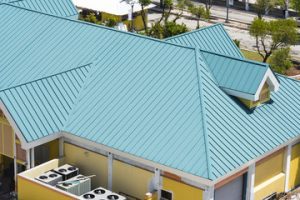Gutters Gainesville FL are crucial for preventing water damage around your home. They also help to maintain the integrity and beauty of your landscape, including delicate flower beds and green lawns.

Gutters protect your home from moisture damage, reducing the risk of mold and mildew. Gutter systems can save you thousands of dollars in costly repairs.
Gutters are troughs, pipes, or indentions along the side of a roof that channel rainwater away from a home. They can be made of a variety of materials, and come in many different shapes and sizes. However, they all accomplish the same basic function: to collect and redirect rainwater to prevent water damage and flooding.
Without gutters, rainwater would simply cascade off the roof and pool around the foundation of the house, eroding the soil and damaging the structure over time. Gutters efficiently redirect the water, reducing soil erosion and protecting the foundation and preventing basement floods and other serious structural issues.
Gutter systems work by collecting the rainwater in the troughs, where it is funneled into downspouts, which then carry the water to a safe drainage area away from the foundation of the house. This reduces the risk of water seepage, preventing basement and crawl space flooding, as well as protects the home from moisture-related problems like mold, mildew, and paint peeling.
In addition, gutters also reduce the potential for flooding and erosion in the landscaping. Without gutters, the water from heavy rainfall can wash dirt into garden beds and landscaping, causing muddy areas and soil erosion. With gutters, the water is channeled away from the landscaping and into a drain, preserving the health of the plants and keeping the yard looking its best.
A properly functioning gutter system, supported by sturdy gutter brackets, can help save homeowners from expensive repairs due to water damage, foundation cracking, and leaky walls. Regular cleaning and inspections ensure that the gutters are clear of clogs, allowing the water to flow smoothly.
The proper installation and maintenance of gutters can also help preserve the lifespan of a roof, lowering repair costs over time. Gutter guards can also be installed, which help prevent clogs and allow the water to flow freely while protecting the gutters from debris. In addition, the regular use of gutters and proper cleaning can help prevent fungal wood rot, water staining on the siding of the house, and mold and mildew growth in attics and basements.
Prevents Mold and Mildew Growth
Gutters can help prevent mold and mildew from growing on your home’s walls and foundation. These fungi thrive in damp, organic settings, which is why it’s important to regularly clean and inspect gutters for signs of damage. If left untreated, mold and mildew spores can be spread around the house by wind, water, or insects and cause further problems and costly repairs. If you notice black or green streaks on your house’s exterior, this is usually a sign that there is a mold problem in the gutter system.
Gutter debris, such as leaves, twigs, and seeds, can block your gutters, causing water to overflow and saturate the surrounding walls and foundation. Regular cleaning removes these materials and keeps your gutters flowing properly.
Clogged gutters can also prevent the flow of water from your roof, which can cause rot, leaks, and even ice dams during colder weather. This can cause significant damage that requires expensive roof repair or replacement.
A well-maintained gutter system helps keep the soil around your home stable and prevents erosion, which can damage the foundation and siding. When soil is eroded, it can wash away dirt and sand that protect your home’s structure and lead to cracking, bowing, or shifting. Gutters ensure that your foundation and siding are not exposed to excess moisture, preventing mold growth, rot, and insect infestations.
Regular gutter maintenance and inspections identify small issues, such as leaks or holes, before they become larger problems. These can be fixed with waterproof caulk and patches designed specifically for gutters, saving you from extensive and expensive repairs.
If you’re looking for a local and trusted company to clean and maintain your gutters, contact us! Our professional gutter services include routine cleaning, clog removal, and inspections for potential damage or other problems. We’re dedicated to ensuring that your gutters are in good condition so you can avoid expensive water damage and maintain a beautiful home. Call today to schedule your free consultation and estimate! Our friendly team is happy to answer any questions you may have. We proudly serve homeowners in Charlotte and the surrounding areas.
Prevents Foundation Damage
Gutters prevent basement flooding by keeping rainwater away from your foundation. This keeps moisture away from walls and floors, which prevents the onset of mold and mildew. In addition, it helps prevent structural damage and water intrusion that could cause cracks in your basement walls or windows.
Without gutters, any water that hits your house’s roof flows directly down the sides and over the foundation. This constant flow of water erodes soil around the foundation and puts pressure on it, causing it to shift and settle unevenly. This creates cracks in the foundation and basement walls, and it can also lead to water intrusion that leads to mold and mildew.
When rainwater collects next to your foundation, it becomes saturated with silt and clay. The water then expands, exerting pressure against the foundation that can cause it to shift and crack. Eventually, this can damage the entire structure of your home. Gutters prevent this by directing water away from your foundation and preserving the soil that protects it.
A properly functioning gutter system directs rainwater and melted snow away from the house. However, clogged or poorly sloped gutters can lead to overflows and dump water too close to the foundation. Additionally, if downspouts are too short or disconnected from the gutters, they cannot adequately channel water away from the house.
If you are noticing sagging sections of your gutter system, rust, or other signs of wear and tear, it’s important to replace them to ensure they can effectively channel water away from the house. Regular inspections can help you identify issues and maintain the performance of your gutter system. For best results, schedule gutter cleaning twice per year to remove debris from the system and ensure that it is correctly funneling water away from the home’s foundation. In Murfreesboro, gutter repair is more than just avoiding water damage and maintaining curb appeal; it’s essential for protecting the health of your home and its foundation. Contact us today to learn how we can enhance your gutter system to keep your home safe from water damage.
Prevents Landscape Erosion
Gutters help to maintain proper drainage around your home, which prevents soil erosion that can impact the integrity of your foundation. This also helps to preserve your meticulously crafted landscaping and garden beds. In the absence of gutters, water can flow off your roof in heavy volumes, which can wash away mulch, erode soil, and uproot plants. Clean, well-functioning gutters channel this water effectively to designated drainage areas, preserving the integrity of your landscape and garden beds.
Erosion occurs in a number of ways, including splash erosion (rainfall hitting the ground and bouncing back up) and sheet erosion (rainfall washing away topsoil in broad sheets). In both cases, this erosion can lead to problems with your home’s foundation. Gutters are designed to prevent both of these issues by collecting rainwater in downspouts and directing it away from your house. This keeps the water away from your foundation, preventing it from seeping into basements and causing costly repairs.
Landscape erosion can also damage your hardscapes, such as patios and walkways. Rainwater flowing over these surfaces can cause cracking and shifting, which can be expensive to repair. Gutters provide a vital line of defense against this erosion, protecting these areas from costly damage by guiding water to designated drainage areas.
Gutters also prevent soil erosion by keeping water from collecting in low-lying areas around your home. When water pools near the foundation, it can undermine the structure of your home and create a host of problems, from sagging floors to cracked walls and crumbling mortar. In the absence of gutters, this water can even reach your basement, causing flooding and costly water damage.
Gutters are a cost-effective way to prevent this type of erosion and protect the investment you’ve made in your outdoor living spaces. To ensure that your gutters are functioning properly, it is important to perform regular cleaning and maintenance. In addition to removing leaves, twigs, and other debris from the system, it’s also a good idea to inspect them for signs of wear or damage, such as holes or cracks. Gutter guards can also be installed to reduce the amount of debris that enters the system, further extending the life of your gutters and reducing the need for frequent cleanings.


